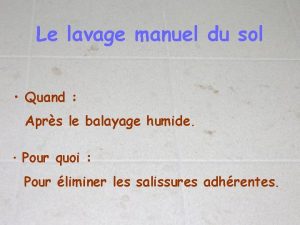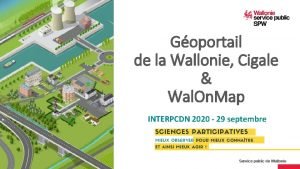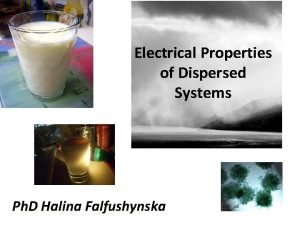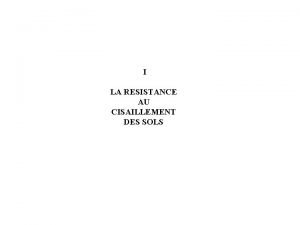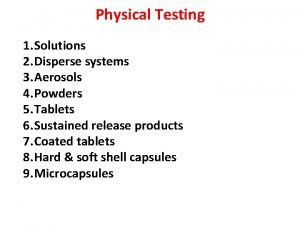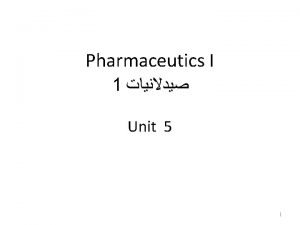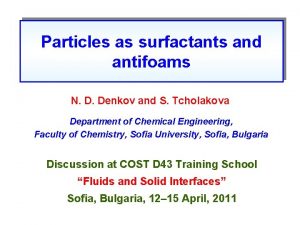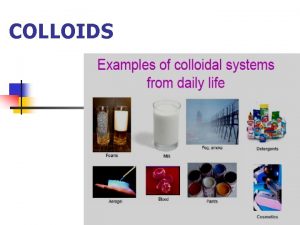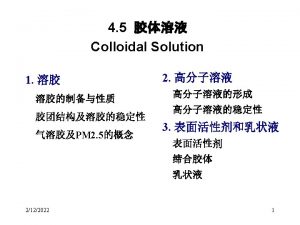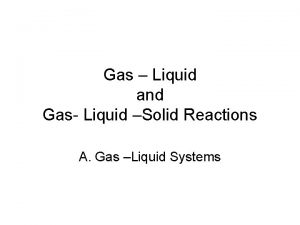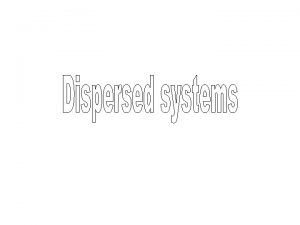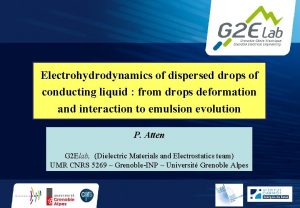4 Solid dispersed in liquid Sols 4 1









- Slides: 9

4 - Solid dispersed in liquid (Sols) (4. 1) Lyophilic (solvent-loving) and Lyophobic (solvent-hating) sols Lyophilic sols are those in which the dispersed phase exhibits a definite affinity for the medium or the solvent while Lyophobic sols are those in which the dispersed phase has no attraction for the medium or the solvent. The examples of Lyophilic sols are dispersions of starch, gum, and protein in water. The examples of Lyophobic sols are dispersion of gold, iron (III) hydroxide and sulphur in water. The affinity or attraction of the sol particles for the medium, in a lyophilic sol, is due to hydrogen bonding with water. If the dispersed phase is a protein (as in egg) hydrogen bonding takes place between water molecules and the amino groups ( –NH–, –NH 2) of the protein molecule.

In a dispersion of starch in water, hydrogen bonding occurs between water molecules and the – OH groups of the starch molecule. There are no similar forces of attraction when sulphur or gold is dispersed in water. Differences between lyophilic and lyophobic sols

(4. 2) Preparation of sols Lyophilic sols may be prepared by simply warming the solid with the liquid dispersion medium e. g. , starch with water. Lyophobic sols have to be prepared by special methods. These methods fall into two categories: Dispersion Methods in which larger macro-sized particles are broken down to colloidal size and Aggregation (Condensation) Methods in which colloidal size particles are built up by aggregating single ions or molecules of true solution

Preparation of colloidal solutions Dispersion methods Condensation methods Mechanical dispersion Excessive cooling Dispersion by ultrasonic vibrations Lowering of solubility Electro dispersion Peptization Double decomposition Oxidation Reduction Hydrolysis Passing vapor of an element into a liquid Chemical action

A- Dispersion Methods 1 - Mechanical dispersion using colloid mill The solid along with the liquid dispersion medium is fed into a Colloid disk mill. The mill consists of two Disk mill steel plates nearly touching each other and rotating in opposite directions with high speed. The solid particles are ground down to colloidal size and are then dispersed in the liquid to give the sol. Colloidal graphite and printing inks are made by this method. Ball mill A colloidal ball mill can also employed to obtain a colloidal solution from suspension. Due to the high speed rotation of the mill the coarse particles roll over one another to form fine particles of the colloidal size.

2 - Dispersion by ultrasonic vibrations In this case, the transformation of coarse particles to the colloidal size is carried out using the ultrasonic vibrations produced by a certain generator. The figure shows the formation of colloidal solution of mercury in water. Ultrasonic vibrations spread through the oil and hit the vessel having mercury under water. The ultrasonic vibrations travels through the walls of the mercury container and produce clouds of mercury which form the mercury sol.

3 - Bredig’s Arc Method It is used for preparing hydrosols of metals e. g. , silver, gold and platinum. An arc is struck between the two metal electrodes held close together in deionized water with trace of alkali. The water is kept cold by immersing the container in ice/water bath. The intense heat of the spark across the electrodes vaporises some of the metal and the vapour condenses under water. Thus the atoms of the metal present in the vapour aggregate to form colloidal particles in water. Since the metal has been ultimately converted into sol particles (via metal vapour), this method has been treated as of dispersion method also.

Non-metal sols can be made by suspending coarse particles of the substance in the dispersion medium and striking an arc between iron electrodes. 4 - Peptization Some freshly precipitated ionic solids are dispersed into colloidal solution in water by the addition of small quantities of electrolytes, particularly those containing a common ion. The precipitate particles adsorbs the common ions to be electrically charged particles, then split from each other to form colloidal solution.

Sol of ferric hydroxide is obtained by stirring fresh precipitate of ferric hydroxide with a small amount of Fe. Cl 3 The transformation of a precipitated material to colloidal solution by the action of an electrolyte in solution, is termed peptization which is the reverse of coagulation and the electrolyte used is called a peptizing agent. Another examples of preparation of sols by peptization is silver chloride, Ag. Cl which can be converted into a sol by adding hydrochloric
